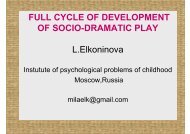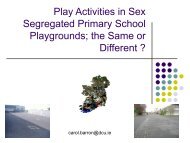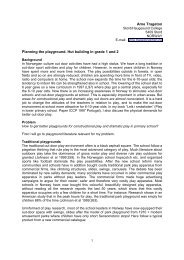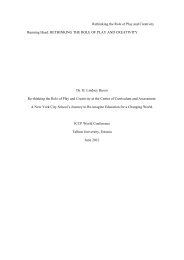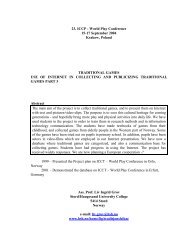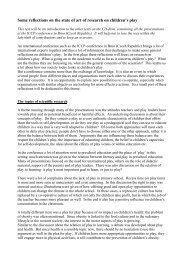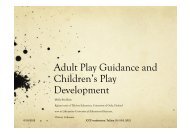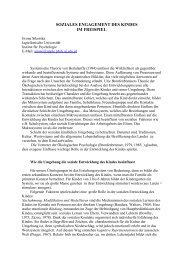Edutainment or Entertainment - International Council for Children's ...
Edutainment or Entertainment - International Council for Children's ...
Edutainment or Entertainment - International Council for Children's ...
You also want an ePaper? Increase the reach of your titles
YUMPU automatically turns print PDFs into web optimized ePapers that Google loves.
The objects with a lower centre of mass do not capsize. It is recommended to use the<br />
commercial toys, oval covers <strong>or</strong> polystyrene eggs. The phenomenon to understand is the<br />
balance of the objects.<br />
Walking hedgehog:<br />
Wooden hedgehog (<strong>or</strong> any other animal) with a functional leg moves down on the inclined<br />
plane. The phenomenon to understand is the gravitation.<br />
Glockenspiel:<br />
A wooden tree has got spiral wooden leaves that are shivered by a ball that is dropped on<br />
those leaves. The phenomenon to understand is the source of sound, the strike tone and<br />
gravitation.<br />
Competitive game<br />
When <strong>or</strong>ganizing the competitive game, we mainly stimulate the social need to win in the<br />
competition of the others. Simple experiment is placed within the framew<strong>or</strong>k of the<br />
competitive game in the f<strong>or</strong>m of a central object. The competition itself focuses on the most<br />
effective demonstration of the experiment.<br />
Soap bubbles:<br />
Pupils <strong>or</strong> representatives of the teams try to do their best to make the biggest bubble using the<br />
straw and the soap fluid. The game is easy to alternate by asking pupils to have the bubble of<br />
certain diameter floating as long as possible. The phenomenon to understand is the surface<br />
tension when making the bubbles.<br />
Liquid surface:<br />
Pupils <strong>or</strong> representatives of the teams try to put objects (coins, stones, balls) into a container<br />
filled with water. The task is to use as many objects as possible without spilling the water. The<br />
phenomenon to understand is the surface tension in the fluids.<br />
Problem game<br />
When <strong>or</strong>ganizing the problem game, the point is to stimulate the need to solve problems.<br />
Simple experiment is once again the central object that contains the problem itself. The game<br />
can take the f<strong>or</strong>m of a puzzle, trick explanation, paradox, etc.<br />
Ball in a glass:<br />
A small ball is placed into a conical glass. The task is to get the ball out and not to touch the<br />
ball and also not to overturn the glass. The solution is to make the ball rotate and the spiral<br />
movement will drive the ball out of the glass. The phenomenon to understand is the<br />
centrifugal f<strong>or</strong>ce.<br />
Strong paper:<br />
Put a strip of paper over the neck of the empty glass. The strip of paper is supposed to hold<br />
the coin from falling into the glass. The paper will not make it. The problem task is possible to<br />
be solved by folding the paper in a concertina style and only then it can hold several coins.<br />
The phenomenon to understand is the solidity and flexibility of objects.<br />
Project game<br />
The highest level of the problem task is a project. The project game should stimulate several<br />
needs; f<strong>or</strong> example, how to solve the problems <strong>or</strong> find one's position in the team. From the<br />
point of view of the time, it is easier to create sh<strong>or</strong>ter perspective project games.




